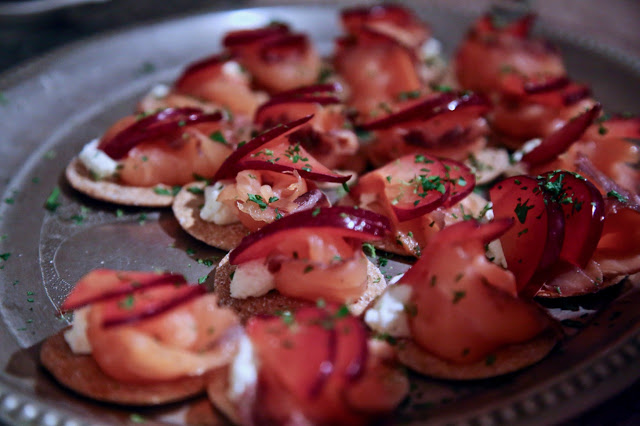
~
~
~
~
~
~
I was commissioned to create a supper club menu around the Flavorking plum. This South African plum, which has a short three week season in early spring, is a combination of plum and apricot, often referred to as a ‘pluot’ or ‘plumcot’. This ingredient is beloved of chefs and keen cooks, and has a slight bubblegum flavour.
I love creating a menu celebrating a single ingredient – it pushes me to be creative. I like to incorporate it in every course from the welcome cocktail to the canapés, through the starter and main course, ending with cheese and dessert. I complemented the Flavorking with plummy ingredients from Asian cuisine, where the plum is often used in savoury dishes.
Mushroom and tofu wontons with plum sauce
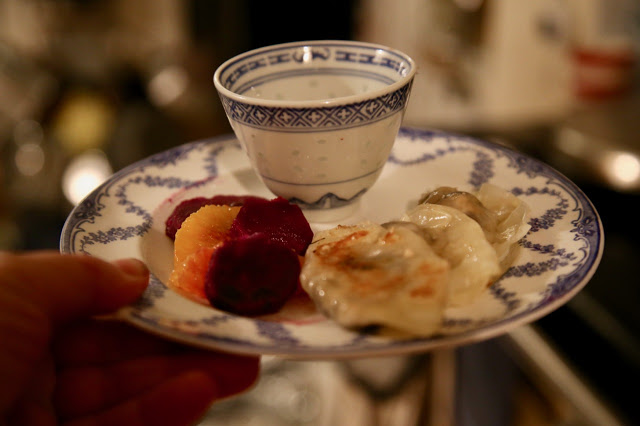
Mushroom and tofu wontons/gyoza with plum sauce recipe
Ingredients
- 3 tbsp of sesame oil
- 2 cloves of garlic, minced
- 1 thumb ginger, peeled and minced
- 1 tbsp of sugar
- 3 tbsp of dark soy sauce
- 1 tsp of 5 spice
- 1 tsp of cornflour
- 1 block firm tofu
- 4 spring onions, the white part, sliced, keep the green part for garnishing
- 250 g shiitake or other mushrooms, sliced finely
- 1 packet gyoza skins or Chinese wonton skins
Recipe for plum sauce:
- 10 plums or pluots, blanched, skin off, stone out
- 5 cloves garlic, minced
- 1 small red onion, diced
- 1 thumb fresh ginger, peeled with a teaspoon and minced
- 3 star anise
- 2 tbsp sugar
- 200 ml sherry vinegar
Instructions
For the plum sauce:
- Make the plum sauce first to get it out of the way. Make a cross on each of the plums with a knife.
- Boil a kettle of water, pour into a heat proof bowl as soon as boiled and plunge the plums into the bowl. Within a minute the skin should start to unfurl from the crosses and you can get to work taking the skin off. Remove the pits too.
- Then put all of the ingredients into a medium saucepan and heat until the plums break down a little, say 10 to 15 minutes.
- Place all the ingredients into a powerful blender such as a Vitamix or use a hand blender and mix at high speed. Taste the sauce to see if it needs anything more - you are looking for a sweet sour zing.
- Pour the ingredients into a chinois or sieve and let it drip into a bowl overnight. You will end up with a clear syrupy sauce.
For the gyoza:
- Make the filling. Put all of the ingredients up to the tofu into a hot wok or frying pan and sizzle for a couple of minutes.
- Strain the tofu of all water and dice it. If the tofu is soft, place it on your hand and cut it on your hand then tip it into the wok. Fry the tofu for five minutes.
- Add the spring onions and mushrooms. The mushrooms will release a lot of liquid. Fry until the mushrooms seem cooked, for about 3-5 minutes.
- Prepare a jug or bowl with a sieve or chinoise. Put all the mixture into the sieve and let the excess liquid drain out. You don't want a very liquid filling as the gyoza skins will not hold it.
- Make a little gyoza filling station on a table. Kids and friends can join in with this and more hands make quick work. Get a small bowl of egg white or a bowl of water (if you are vegan) next to each person. Take a stack of gyoza skins for each person. Put the large bowl of cooled filling in the middle and give each person a teaspoon.
- Lay out the gyoza skin and dip your finger into the egg white or water, run it around the border of the gyoza/pot sticker/chinese dumpling/wonton skin. Put a heaped teaspoon of filling into the middle then seal the gyoza according to the pictures below. You want four folds on one side, which creates a crescent shaped dumpling.
- Store them on a tray sprinkled generously with white flour, rice or wheat, so that they won't stick to the bottom when you remove them to steam.
- Boil a kettle. On a medium to low heat, place a non-stick or well seasoned cast iron frying pan with a lid and add a little vegetable or groundnut oil. When the oil is hot, place the gyoza carefully into the pan, making sure they don't touch, and fry the bottoms until golden, 3 to 5 minutes, then add a couple of centimetres (an inch) of boiling water from the kettle. Stand back as this may splatter a little. Put the lid on. Then steam for 5 minutes or so. Using a fish slice, remove the gyoza and add a few more drops of oil, start the next batch. continue until you have finished all the filled gyoza.
- Serve them hot with the reserved green part of the spring onion and the plum dipping sauce.
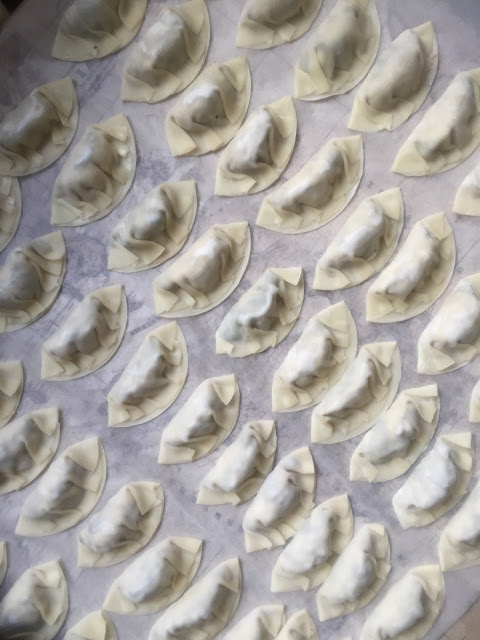
Purple sweet potato and blood orange salad
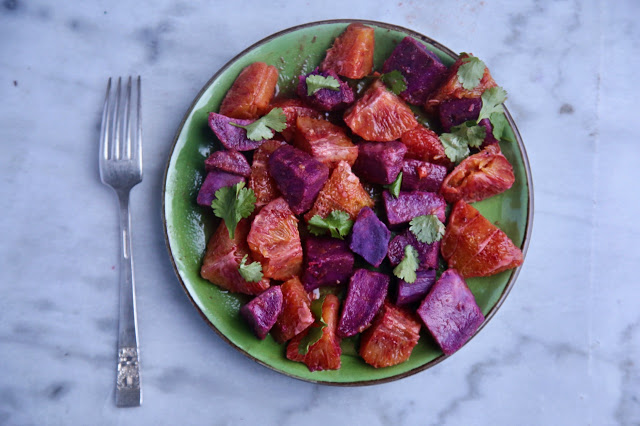
Purple sweet potato and blood orange salad
Ingredients
- 3 long thin sweet potatoes, washed
- 3 blood oranges, peeled, segmented
- Juice 1 lime
- 1 tsp sea salt
- 1 red chilli, finely sliced
- A handful of coriander leaves
Instructions
- Place the whole sweet potatoes into a medium saucepan onto a high heat. Do not remove the skins as this will leach some of the purple pigment. (When I cook blue, purple or red potatoes, I always boil with the skins left on). Boil for 15 to 20 minutes until a fork enters the potato easily. Remove from the heat and drain the sweet potatoes. Peel them with your fingers when cool enough to handle. Slice into pound coin thick slices. Set aside to cool.
- Prepare the oranges by peeling with a knife then segmenting. This technique is known as 'supreme' and you can look at Youtube videos to learn how. However if you can't be bothered to do that, you can also cut the potatoes and oranges into chunks, as in the picture above.
- Mix the orange segments with the cooled sweet potatoes and add the juice of a lime. Add the salt, chilli and coriander. Toss and serve.
Sea bass en papillote with plum noodles, umeboshi plums and plum salsa
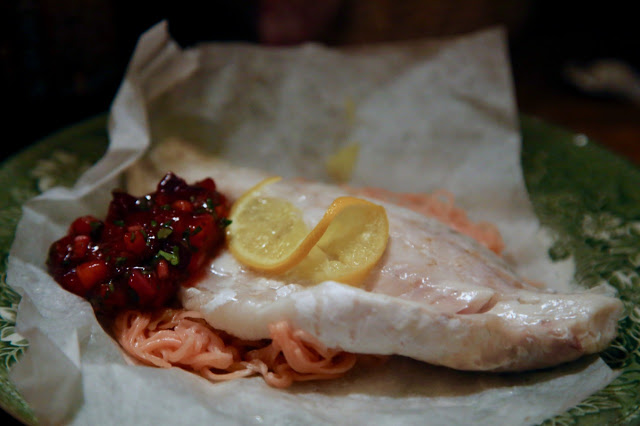
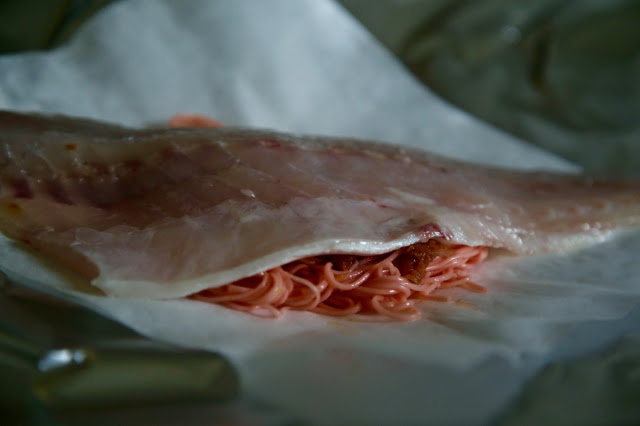
Sea bass en papillote with plum noodles, umeboshi plums and plum salsa
Ingredients
For the fish:
- 200 g soba noodles with plum extract, briefly blanched in hot water, drained
- 2 tbsp of groundnut oil
- Zest of 2 bergamots or citron beldi, use the juice of one and thinly slice for other
- 4 umeboshi plums, chopped finely
- 4 sea bass filets, skinned, boned
- 2 tsp sea salt
For the plum salsa:
- 4 Flavorking plums, stoned
- 1/2 red onion, diced
- 1 jalapeno chilli, roasted, seeded, thinly sliced
- Juice of 1 lime
- 1.5 tsp sea salt
- Handful of coriander
Instructions
- Preheat the oven to 200ºC. Put the soba noodles into a large saucepan of boiling salted water on a high heat. 'Blanch', that is, boil, for 60 seconds, then drain into a colander and rinse with cold water. Toss in a bowl with 2 tbsp of groundnut oil, the zest of 2 bergamots and the juice of 1 bergamot. (Use lemons when bergamots are out of season; Meyer lemon is also acceptable.)
- Place the smaller squares of parchment paper onto the larger squares of tin foil. Place a quarter of the noodles onto one of your squares of parchment paper. Add 1 umeboshi plum chopped finely (this is very salty so if you don't use this, season your fish with salt). Then add the sea bass filet on top. Add a slice of bergamot to the top of the fish and close the tin foil packet.
- Place all four filets into the baking tin and roast for 15 to 20 minutes. Using a digital thermometer, stick it straight through the foil into the fish - if it's over 60ºC, it's cooked.
- Remove from the oven, open the packets and remove the parchment paper, topped with noodles and fish straight onto the plate. Discard the tin foil. Serve hot as is.
Plum fruit leather
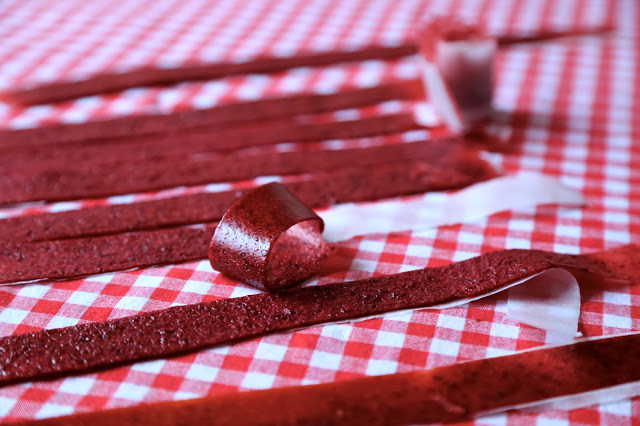
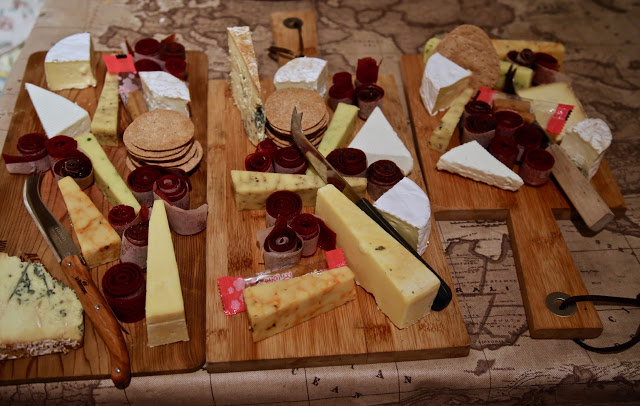
Plum fruit leather
Ingredients
- 1 kilo of plums, stoned
- 4 tbsp of honey, maple syrup or agave nectar
- Optional add ons:
- 2 tsp citric acid
- 2 tsp freeze dried raspberry
- 2 tsp black sesame seeds
- 2 tsp black poppy seeds
Instructions
- Preheat the oven to 100ºC. I am lucky enough to have a very powerful blender, a Vitamix, which meant that I didn't have to skin the plums. Otherwise, make crosses on the top of each plum, with a knife, and leave them for 30 seconds in boiling water. The skin should come off easily. Remove the stones.
- With a powerful blender, pulse the flesh, then add agave, honey or maple syrup. You can use sugar but honey or agave means that there is less chance of crystallisation than with sugar. You also have the choice of putting in less sweetener or none at all.
- Prepare a flat baking tray with a Silpat silicone mat. With a spatula, spread out the plum purée to about 1/4 inch or 1/2 cm thick. You want it thin enough to dry out but not so thin that you do not have a 'rollable' leather. Make sure you can't see through the purée and remember it will contract as it dries.
- To one sheet I added citric acid to get that fizzy sour flavour, on another I added freeze dried raspberries. I scattered black sesame seeds over the pulp for a final sheet. I also tried black poppy seeds. I put the fruit in a low oven, 100ºc for several hours. I kept checking hourly. It's hard to say exactly how long it will take but you could put it in for 2 or 3 hours on 100ºc then turn the oven off and leave it overnight to dry out.
- When it's sufficiently dried out, carefully peel the leather off the silicone sheet and place it onto parchment paper. Cut it into strips and roll it. This is also a perfect lunchbox snack for schoolchildren.
Plum clafoutis
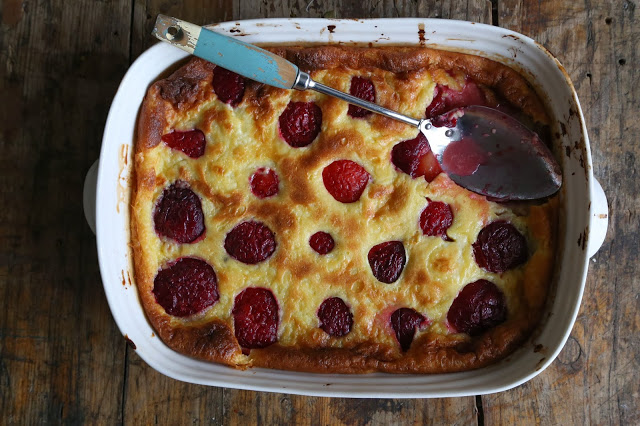
Plum clafoutis
Ingredients
- 10 large ripe plums, in this case Sapphire plums, cut in half and stoned
- 20 g butter for greasing
- 4 eggs
- 150 g caster sugar
- 50 g plain flour
- 600 ml double cream
Instructions
- Prepare the plums by cutting them in half along the dimple from the root and twisting. Remove the pits.
- You'll need a buttered/greased baking dish/tray of approximately 25cm x 30cm.
- Preheat the oven to 180ºC.
- Place the plums, cut side down, in the baking tray.
- Whisk the eggs then add the sugar. Slowly sift in the flour, while stirring, then add the cream, whisking thoroughly.
- Pour the batter over the fruit.
- Bake in the oven for 30 minutes or until set.




Nice good looking colors of that salad with sweet potatoes and blood orange. Looking so exotic and delicious. I also like that Plum clafoutis, is it looking like a pie. Thanks for the recipes I will try the Plum clafoutis.